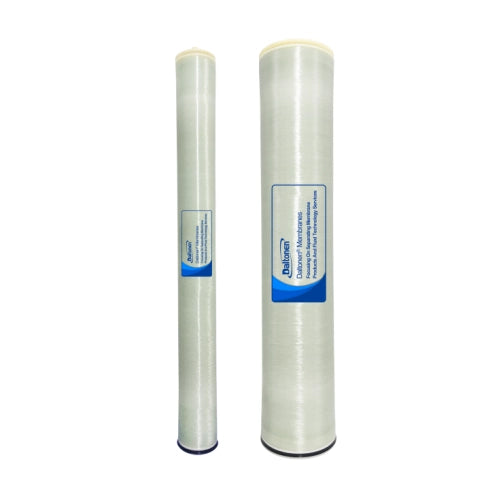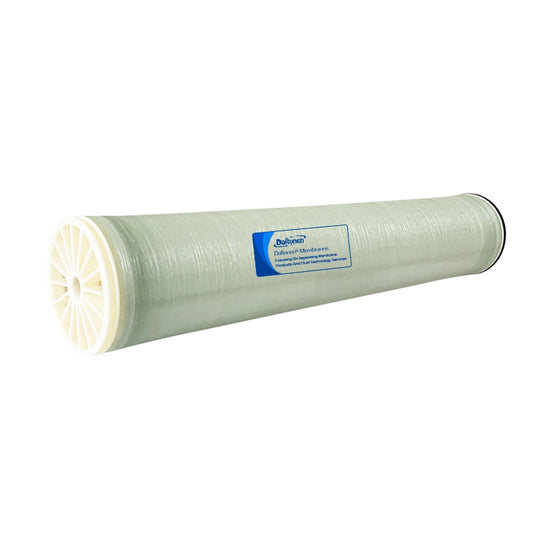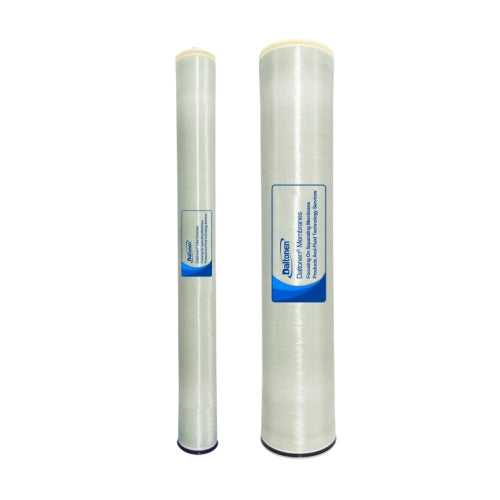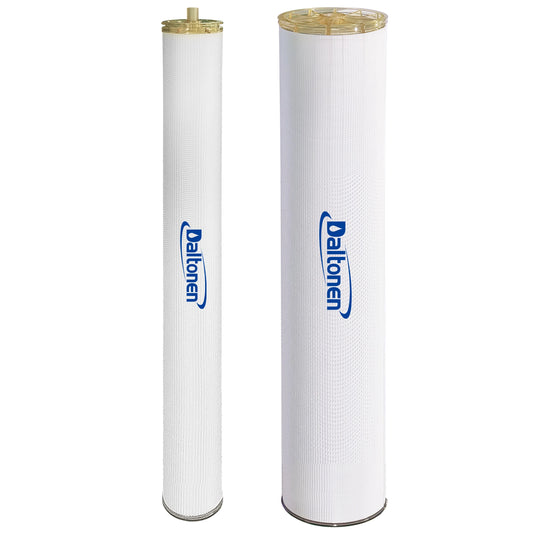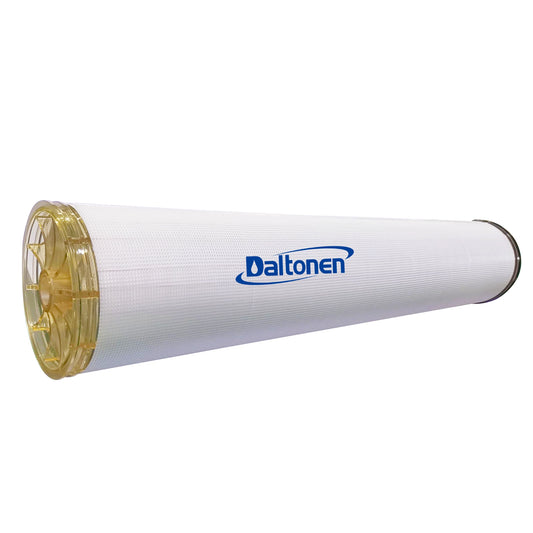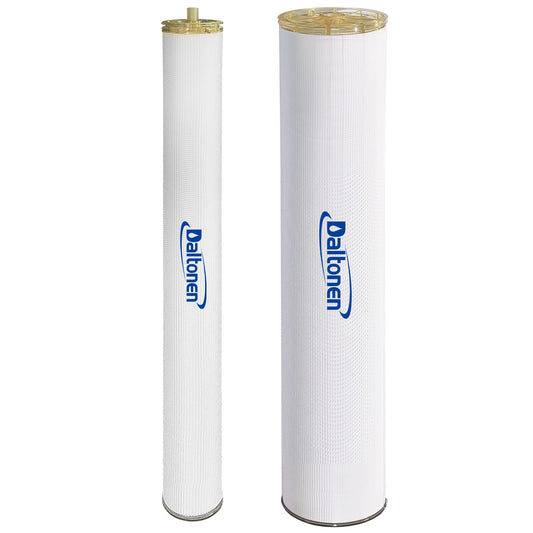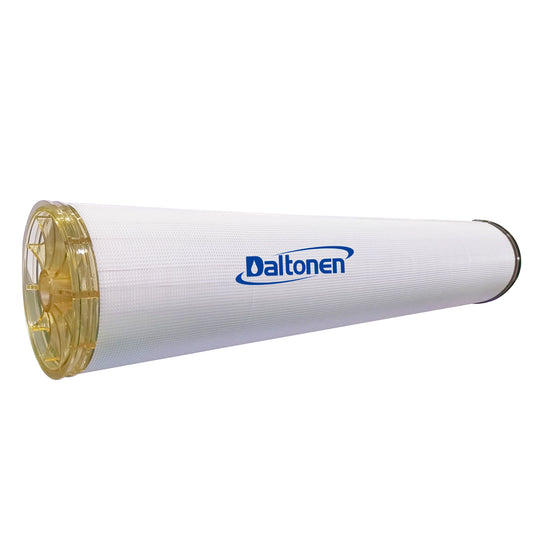How to Choose the Right RO Membrane for High-Temperature Dyeing Wastewater
10 Jun 2025
1. Characteristics of High-Temperature Dyeing Wastewater
1.1 Complex Water Quality Components
The complex water quality components of high-temperature dyeing wastewater mainly include the following aspects:
-
Organic Pollutants: Dyeing wastewater contains a large amount of organic pollutants, such as dyes, auxiliaries, and sizing agents. These organic substances are diverse in type and chemical nature, and some are difficult to degrade. Research indicates that the chemical oxygen demand (COD) of dyeing wastewater is typically between 1000-3000 mg/L, and even higher, which shows that the wastewater has a high content of organic substances and poses a significant threat to the environment.
-
High Salinity: The use of salts (such as sodium chloride and sodium sulfate) in the dyeing process significantly increases the salinity of the wastewater. High salinity can affect the performance of RO membranes, reducing their desalination rate and water flux. Generally, the salinity of dyeing wastewater can reach 10-30 g/L, which puts high demands on the salt tolerance of RO membranes.
-
High Color Intensity: Dyeing wastewater usually has a deep color and high color intensity due to the presence of a large number of dye molecules, which have strong light absorption properties. The color intensity of dyeing wastewater is generally between 100-500 times, and even higher. High-color wastewater not only affects the aesthetics of water bodies but also has phototoxic effects on aquatic life.
-
High Temperature: The temperature of dyeing wastewater is usually high, generally between 40-60℃. The high temperature of wastewater directly affects the heat resistance of RO membranes. If the RO membrane cannot withstand high temperatures, it may lead to a decline in membrane performance or even damage. Therefore, when selecting an RO membrane, its heat resistance must be considered to ensure stable operation under high-temperature conditions.
-
Suspended Solids and Colloidal Substances: Dyeing wastewater also contains a certain amount of suspended solids and colloidal substances, such as fiber fragments and sizing particles. These substances can clog the pores of RO membranes, leading to a decrease in water flux. The content of suspended solids in wastewater is generally between 100-300 mg/L, and the content of colloidal substances is also relatively high. Therefore, it is necessary to pre-treat the wastewater to remove most of the suspended solids and colloidal substances to reduce pollution to RO membranes.

2. Classification and Characteristics of RO Membranes
2.1 Material Differences
The material of RO membranes is one of the key factors affecting their performance. Common RO membrane materials include cellulose acetate (CA), polyamide (PA), and polyethersulfone (PES).
-
Cellulose Acetate Membrane: Cellulose acetate membranes have good chemical resistance and biodegradability, making them suitable for treating wastewater containing organic solvents or microorganisms. However, their heat resistance is relatively poor, and they can only operate stably at temperatures around room temperature to 40℃. In the treatment of high-temperature dyeing wastewater, the application of cellulose acetate membranes is limited due to the high temperature of the wastewater.
-
Polyamide Membrane: Polyamide membranes are one of the most widely used RO membranes today, with high desalination rates and good water flux. They have good heat resistance and can operate stably at temperatures between 40-60℃, making them suitable for treating high-temperature dyeing wastewater. However, the chemical resistance of polyamide membranes is relatively weak, and they are susceptible to erosion by strong acids, strong bases, and oxidizing agents. In dyeing wastewater, the presence of a large number of chemical substances may have an adverse effect on the performance of polyamide membranes.
-
Polyethersulfone Membrane: Polyethersulfone membranes have good chemical resistance and heat resistance, and can operate stably at temperatures between 60-80℃. Their disadvantage is that the desalination rate is relatively low, generally between 90%-95%. In the treatment of high-temperature dyeing wastewater, polyethersulfone membranes can effectively remove salts and some organic substances from the wastewater, but their treatment effect on high-concentration organic pollutants may not be as good as that of polyamide membranes.
2.2 Heat Resistance
The heat resistance of RO membranes is an important consideration when selecting them for the treatment of high-temperature dyeing wastewater.
-
Temperature Range: Different RO membrane materials have different temperature ranges. As mentioned earlier, the temperature range for cellulose acetate membranes is generally from room temperature to 40℃, for polyamide membranes it is 40-60℃, and for polyethersulfone membranes it is 60-80℃. Since the temperature of dyeing wastewater is usually between 40-60℃, polyamide and polyethersulfone membranes are more suitable choices.
-
Factors Affecting Heat Resistance: The heat resistance of RO membranes is not only related to the material but also affected by the membrane's preparation process and structure. For example, optimizing the membrane preparation process can improve the membrane's heat resistance and stability. Additionally, the thickness and pore size of the membrane also affect its heat resistance. Generally speaking, thicker membranes have better heat resistance, but lower water flux; while thinner membranes have higher water flux, but may have poorer heat resistance.
-
Heat Resistance Testing in Practical Applications: In practical applications, it is necessary to test the heat resistance of RO membranes to ensure their stable operation in the treatment of high-temperature dyeing wastewater. The testing method includes placing the RO membrane in wastewater at different temperatures and observing the changes in water flux, desalination rate, and physical properties of the membrane. For example, in high-temperature dyeing wastewater at 40-60℃, the water flux of polyamide membranes generally decreases by 10%-20%, and the desalination rate decreases by 5%-10%; while the water flux of polyethersulfone membranes decreases by 5%-15%, and the desalination rate decreases by 3%-8%. These data can provide a reference for selecting the appropriate RO membrane.
3. Key Factors in Selecting RO Membranes
3.1 Pore Size of the Membrane
The pore size of the membrane is crucial for the treatment of high-temperature dyeing wastewater.
-
Matching with Pollutant Size: Dyeing wastewater contains a variety of pollutants, such as dye molecules, auxiliary molecules, and fiber fragments, which vary in size. The diameter of dye molecules is generally between 1-10 nm, the diameter of auxiliary molecules is between 0.5-5 nm, and the size of fiber fragments is relatively large, generally between 10-100 nm. Therefore, the pore size of the RO membrane should be smaller than the size of these pollutants to effectively intercept them. For example, for treating dyeing wastewater containing a large number of dye molecules, selecting an RO membrane with a pore size between 0.1-1 nm is more appropriate, which can ensure that most dye molecules are intercepted, thereby reducing the color intensity and organic content of the wastewater.
-
Impact on Water Flux and Desalination Rate: The pore size of the membrane also affects the water flux and desalination rate of the RO membrane. Generally, the smaller the pore size, the lower the water flux but the higher the desalination rate; the larger the pore size, the higher the water flux but the lower the desalination rate. In the treatment of high-temperature dyeing wastewater, it is necessary to comprehensively consider the water flux and desalination rate based on the water quality and treatment requirements of the wastewater to select the appropriate pore size. For example, if the wastewater has a high salinity and requires a high desalination rate, an RO membrane with a smaller pore size can be chosen; if the wastewater has a low salinity but requires a higher water flux, an RO membrane with a slightly larger pore size can be selected.
3.2 Fouling Resistance
The complex water quality of high-temperature dyeing wastewater, containing a large amount of organic pollutants, suspended solids, and colloidal substances, easily forms a fouling layer on the surface of RO membranes, leading to a decrease in water flux and deterioration of membrane performance.
-
Impact of Surface Properties on Fouling Resistance: The surface properties of RO membranes, such as hydrophilicity and surface charge, have an important impact on their fouling resistance. RO membranes with hydrophilic surfaces have better anti-fouling capabilities because hydrophilic surfaces can reduce the adsorption and deposition of pollutants on the membrane surface. Research shows that the rate of water flux decline for hydrophilic RO membranes is 30%-50% lower than that for hydrophobic RO membranes. Moreover, RO membranes with a negative surface charge can produce electrostatic repulsion with positively charged pollutants in the wastewater, thereby reducing pollutant adsorption and enhancing fouling resistance.
-
Impact of Membrane Structure on Fouling Resistance: The structure of the RO membrane, such as thickness, porosity, and pore size distribution, also affects its fouling resistance. Thicker membranes have better mechanical strength and fouling resistance, but lower water flux; thinner membranes have higher water flux, but may have poorer fouling resistance. Higher porosity membranes can provide more water flow channels, reducing the accumulation of pollutants on the membrane surface, thereby enhancing fouling resistance. Additionally, membranes with uniform pore size distribution can more effectively intercept pollutants and reduce membrane surface fouling.
-
Fouling Resistance Testing in Practical Applications: In practical applications, it is necessary to test the fouling resistance of RO membranes to assess their suitability for the treatment of high-temperature dyeing wastewater. The testing method includes operating the RO membrane in dyeing wastewater for a period of time and then measuring indicators such as the rate of water flux decline and pollutant interception rate. For example, in the treatment of high-temperature dyeing wastewater, the rate of water flux decline for hydrophilic polyamide membranes is generally 0.1-0.2 L/m²·h·MPa, with a pollutant interception rate between 90%-95%; while the rate of water flux decline for hydrophobic polyamide membranes is generally 0.3-0.5 L/m²·h·MPa, with a pollutant interception rate between 80%-85%. These data can provide a reference for selecting RO membranes with strong fouling resistance.
4. Impact of Pre-treatment on RO Membranes
4.1 Selection of Pre-treatment Processes
The selection of pre-treatment processes has a crucial impact on the performance and service life of RO membranes. The complex components and high pollution characteristics of high-temperature dyeing wastewater require pre-treatment processes to effectively remove suspended solids, colloidal substances, some organic substances, and color from the wastewater, thereby reducing the burden on RO membranes and improving their operational efficiency and stability.
-
Coagulation and Sedimentation: Coagulation and sedimentation is a commonly used pre-treatment method. By adding coagulants to the wastewater, suspended solids and colloidal substances in the wastewater can be aggregated into larger particles, which are then easily removed by sedimentation. Common coagulants include aluminum sulfate and polyaluminum chloride. Research shows that coagulation and sedimentation can remove 60%-80% of suspended solids and 30%-50% of organic substances from the wastewater, significantly reducing the turbidity and color intensity of the wastewater. For example, in the wastewater treatment of a dyeing factory, after coagulation and sedimentation pre-treatment, the content of suspended solids in the wastewater decreased from 300 mg/L to 60 mg/L, and the color intensity decreased from 300 times to 100 times, effectively reducing pollution to the RO membrane.
-
Filtration: Filtration is another important pre-treatment process. Common filtration media include sand filters and activated carbon filters. Sand filters can effectively remove suspended solids and larger particles from the wastewater, while activated carbon filters can not only remove suspended solids but also adsorb some organic substances and color. Research shows that after treatment with a combination of sand filtration and activated carbon filtration, the content of suspended solids in the wastewater can be reduced to below 30 mg/L, the organic substance content can be reduced by 20%-30%, and the color intensity can be reduced by 50%-70%. In practical applications, a dyeing factory used a combination of sand filtration and activated carbon filtration as pre-treatment for the RO membrane. The rate of water flux decline for the RO membrane was significantly reduced, and its service life was extended by 30%-50%.
-
Oxidation Treatment: Oxidation treatment can effectively decompose organic pollutants in dyeing wastewater, reducing the chemical oxygen demand (COD) and color intensity of the wastewater. Common oxidants include ozone and hydrogen peroxide. Research shows that ozone oxidation can reduce the COD of dyeing wastewater by 30%-50% and the color intensity by 60%-80%. For example, in the wastewater treatment of a dyeing factory, after ozone oxidation pre-treatment, the COD of the wastewater decreased from 2500 mg/L to 1200 mg/L, and the color intensity decreased from 500 times to 100 times, significantly improving the biodegradability of the wastewater and the treatment efficiency of the RO membrane.
-
Membrane Separation Pre-treatment: Membrane separation pre-treatment is an efficient pre-treatment method. Common membrane separation technologies include ultrafiltration (UF) and microfiltration (MF). Ultrafiltration and microfiltration can effectively remove suspended solids, colloidal substances, and some organic substances from the wastewater, providing higher quality influent for the RO membrane. Research shows that ultrafiltration pre-treatment can remove more than 90% of suspended solids and 50%-70% of organic substances from the wastewater, significantly improving the water flux and desalination rate of the RO membrane. In practical applications, a dyeing factory used ultrafiltration as pre-treatment for the RO membrane. The water flux of the RO membrane increased by 20%-30%, the desalination rate increased by 5%-10%, and the operating cost decreased by 15%-20%.
-
Comprehensive Pre-treatment Processes: In practical high-temperature dyeing wastewater treatment, a single pre-treatment process often fails to achieve ideal treatment results. Therefore, comprehensive pre-treatment processes are usually adopted. For example, coagulation and sedimentation can first be used to remove most of the suspended solids and some organic substances, followed by sand filtration and activated carbon filtration to further remove residual suspended solids and organic substances, and finally ultrafiltration or microfiltration for in-depth treatment to provide high-quality influent for the RO membrane. This comprehensive pre-treatment process can fully leverage the advantages of each pre-treatment method, maximizing the reduction of RO membrane pollution and improving its operational efficiency and service life.

5. Cost Considerations
5.1 Purchase Cost
Purchase cost is one of the important factors to consider when selecting RO membranes for high-temperature dyeing wastewater treatment.
-
Cost Differences of Different Material Membranes: There are significant differences in the purchase costs of RO membranes made of different materials. Generally speaking, the purchase cost of cellulose acetate membranes is relatively low, with a price of about 50-100 yuan per square meter; polyamide membranes have better performance, but their purchase cost is also relatively high, with a price of 150-300 yuan per square meter; polyethersulfone membranes have the highest purchase cost due to their excellent heat and chemical resistance, with a price usually ranging from 300 to 500 yuan per square meter. When selecting RO membranes, it is necessary to comprehensively consider their performance and purchase cost to achieve an economically reasonable effect.
-
Impact of Membrane Area Demand on Purchase Cost: The treatment volume of high-temperature dyeing wastewater determines the required RO membrane area. For large-scale dyeing wastewater treatment plants, a larger membrane area is needed to meet the treatment demand, which will lead to higher purchase costs. For example, for a dyeing wastewater treatment plant with a daily treatment capacity of 10,000 tons, if polyamide membranes are chosen, assuming that each square meter of membrane can treat 1 ton of wastewater per day, then 10,000 square meters of membrane are needed, and the purchase cost will be as high as 1.5 to 3 million yuan. Therefore, when selecting RO membranes, it is necessary to reasonably determine the membrane area and material according to the actual treatment volume and budget to reduce purchase costs.
5.2 Operation and Maintenance Costs
Operation and maintenance costs play an important role in the entire use process of RO membranes, mainly including energy consumption costs, cleaning costs, and replacement costs.
-
Energy Consumption Costs: The treatment of high-temperature dyeing wastewater with RO membranes requires a certain amount of energy to maintain the operating pressure, thereby realizing the permeation of water and the interception of pollutants. Generally speaking, energy consumption costs are closely related to the water flux and operating pressure of the membrane. The higher the water flux, the more wastewater can be treated per unit of time, and the lower the energy consumption; the higher the operating pressure, the higher the energy consumption. For example, when polyamide membranes treat high-temperature dyeing wastewater, the operating pressure is generally between 1.5 and 2.5 MPa, and energy consumption costs account for 30%-40% of the total operating costs; while polyethersulfone membranes have relatively larger pores and lower operating pressure, so their energy consumption costs are relatively lower, accounting for 20%-30% of the total operating costs. Therefore, when selecting RO membranes, it is necessary to consider their water flux and operating pressure to reduce energy consumption costs.
-
Cleaning Costs: The complex components of high-temperature dyeing wastewater easily lead to fouling on the surface of RO membranes, which requires regular cleaning to restore membrane performance. Cleaning costs include the cost of cleaning agents, labor costs, and equipment depreciation costs. Generally speaking, cleaning costs are related to the fouling resistance of the membrane and the cleaning frequency. Membranes with strong fouling resistance have lower cleaning frequencies and lower cleaning costs. For example, hydrophilic polyamide membranes have good anti-fouling capabilities, and the cleaning cycle can reach 1-2 months, with cleaning costs accounting for 10%-15% of the total operating costs; while hydrophobic polyamide membranes have shorter cleaning cycles, generally 2-3 weeks, and cleaning costs account for 15%-20% of the total operating costs. Therefore, when selecting RO membranes, it is necessary to consider their fouling resistance to reduce cleaning costs.
-
Replacement Costs: RO membranes will gradually age and become damaged during use and need to be replaced regularly. Replacement costs are related to the service life and purchase cost of the membrane. Generally speaking, the longer the service life, the lower the replacement costs. For example, the service life of cellulose acetate membranes is generally 1-2 years, resulting in higher replacement costs; polyamide membranes have a service life of generally 3-5 years, with relatively lower replacement costs; polyethersulfone membranes have a service life of generally 5-8 years, with the lowest replacement costs. When selecting RO membranes, it is necessary to comprehensively consider their service life and purchase cost to reduce replacement costs.
6. Manufacturers and Technical Support
6.1 Reliability Assessment
When selecting RO membranes for high-temperature dyeing wastewater treatment, the reliability of the manufacturer is one of the key factors. Reliable manufacturers can provide high-quality products and continuous technical support to ensure the stable operation of RO membranes in the complex dyeing wastewater treatment environment.
-
Manufacturer Reputation: Selecting manufacturers with a good market reputation is crucial. For example, well-known international manufacturers such as DuPont and Hydranautics have many years of experience in the RO membrane field. Their products are widely used globally and have a high market share. These manufacturers' products have undergone strict quality control and testing and can meet the strict requirements for high-temperature dyeing wastewater treatment.
-
Product Quality Certification: The manufacturer's products should pass international authoritative certifications, such as the ISO 9001 quality management system certification and the ISO 14001 environmental management system certification. These certifications indicate that the manufacturer strictly follows international standards in the production process, and the quality and environmental performance of the products are guaranteed. For example, manufacturers with ISO 9001 certification usually have a product qualification rate of over 95%, which can effectively reduce the operational risks caused by product quality issues.
-
Practical Application Cases: Assessing the manufacturer's practical application cases in the field of high-temperature dyeing wastewater treatment is an important part of reliability assessment. For example, the RO membrane products of a domestic manufacturer have been successfully applied in several dyeing factories, treating more than 10,000 tons of wastewater per day. The operation is stable, and the water flux and desalination rate of the membrane meet the design requirements. These practical cases provide a strong reference for selecting the appropriate RO membrane.
6.2 After-Sales Service
High-quality after-sales service can effectively extend the service life of RO membranes, reduce operating costs, and improve the overall efficiency of the system.
-
Technical Support: The manufacturer should provide a professional technical support team that can promptly respond to customer technical inquiries and feedback on problems. For example, when the performance of the RO membrane declines or malfunctions during operation, the technical support team should provide solutions within 24 hours to ensure that the system returns to normal operation as soon as possible. In addition, the technical support team should also regularly provide technical training for customers to help them better understand and operate the RO membrane system.
-
Spare Parts Supply: Timely spare parts supply is an important guarantee for the normal operation of the RO membrane system. Reliable manufacturers should establish a complete spare parts inventory system and be able to quickly provide the required membrane elements, seals, valves, and other spare parts. For example, a well-known international manufacturer has established several spare parts warehouses in China and can deliver spare parts to the customer site within 48 hours, greatly reducing the downtime caused by spare parts shortages.
-
Long-Term Cooperation and Maintenance Services: Selecting manufacturers that can provide long-term cooperation and maintenance services helps reduce the overall operating costs of the system. For example, some manufacturers provide regular membrane cleaning and performance testing services, which can effectively extend the service life of the membrane and maintain the efficient operation of the system. In addition, long-term cooperating manufacturers can also provide customized solutions and technical upgrade services according to the actual needs of customers, ensuring that the system is always in the best operating condition.
7. Summary
In the treatment of high-temperature dyeing wastewater, selecting the appropriate RO membrane is a complex and critical decision-making process. High-temperature dyeing wastewater has complex water quality, diverse components, high temperature, high salinity, high color intensity, and a large amount of suspended solids, which pose extremely high demands on the performance of RO membranes.
From the classification and characteristics of RO membranes, different materials have different advantages and limitations. Cellulose acetate membranes have good chemical resistance but poor heat resistance; polyamide membranes have high desalination rates and good heat resistance but weak chemical resistance; polyethersulfone membranes have good heat and chemical resistance but relatively low desalination rates. Therefore, when selecting RO membranes, it is necessary to comprehensively consider the material, heat resistance, pore size, fouling resistance, and cost of the membrane based on the specific characteristics and treatment requirements of the wastewater.
The pore size of the membrane directly affects the interception of pollutants, water flux, and desalination rate. Smaller pores can effectively intercept pollutants but have lower water flux; larger pores have higher water flux but lower desalination rates. Fouling resistance depends on the surface properties and structure of the membrane. Hydrophilic surfaces and membranes with negative surface charges can reduce pollutant adsorption and enhance fouling resistance. Thicker membranes, membranes with higher porosity, and membranes with uniform pore size distribution also help to improve fouling resistance.
Pre-treatment processes have a crucial impact on the performance and service life of RO membranes. Coagulation and sedimentation, filtration, oxidation treatment, and membrane separation pre-treatment can effectively remove suspended solids, colloidal substances, some organic substances, and color from the wastewater, reducing the burden on RO membranes and improving their operational efficiency and stability. Comprehensive pre-treatment processes can fully leverage the advantages of each method to provide higher quality influent for the RO membrane.
Cost considerations are also indispensable when selecting RO membranes. Purchase costs, operation and maintenance costs (including energy consumption costs, cleaning costs, and replacement costs) need to be comprehensively weighed. There are significant differences in the purchase costs of different materials, and the required membrane area also affects the purchase costs. Operation and maintenance costs are closely related to the water flux, operating pressure, fouling resistance, and service life of the membrane.
Finally, the reliability of manufacturers and technical support is also very important for the selection of RO membranes. Selecting manufacturers with a good reputation, quality certification, and practical application cases can ensure product quality and stability. High-quality after-sales service, including technical support, spare parts supply, and long-term cooperation and maintenance services, can effectively extend the service life of RO membranes, reduce operating costs, and improve the overall efficiency of the system.
In summary, selecting the appropriate RO membrane requires a comprehensive consideration of multiple factors such as wastewater characteristics, membrane performance, pre-treatment processes, costs, and manufacturer support to achieve the best treatment effect and economic benefits.
Tags:
